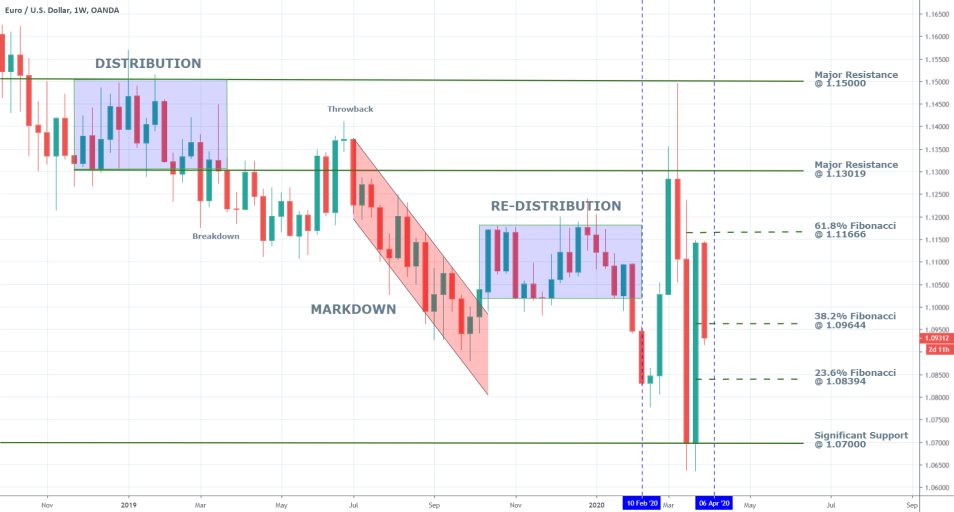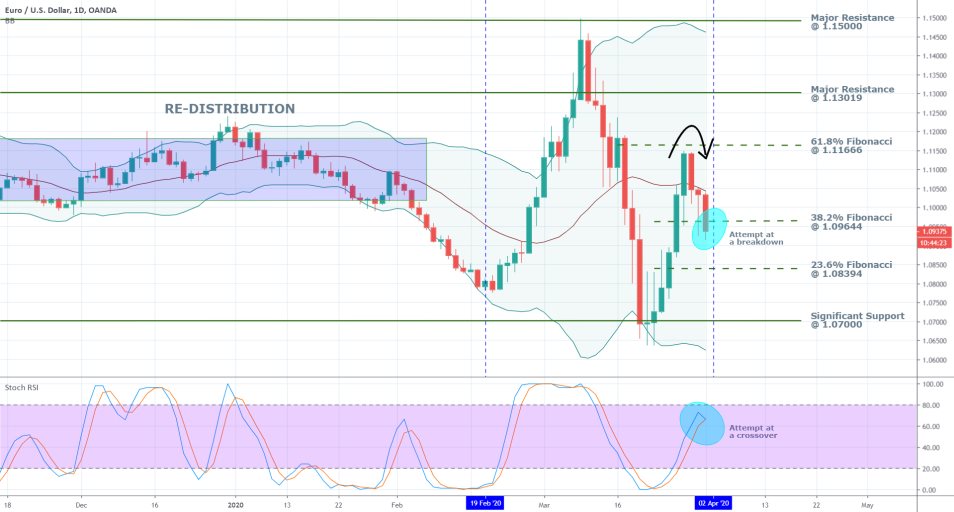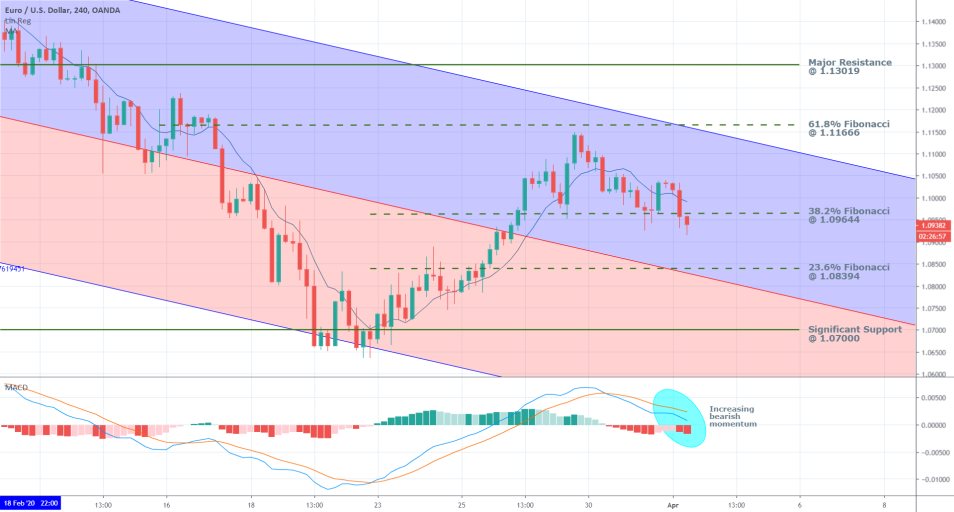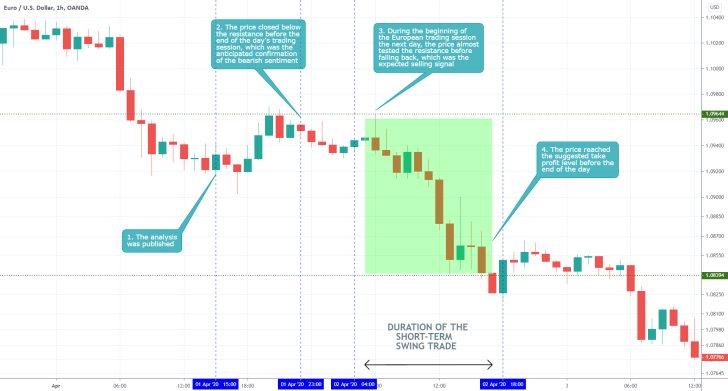The EURUSD has had turbulent few weeks, in which the underlying volatility defining the price action of the world’s two most popular currencies has increased drastically. Sudden surges followed by equally startling collapses in demand have prompted severe fluctuations in the pair’s price action, which is currently being inspired by dramatic shifts in tone in the continually developing coronavirus situation.
Investors and traders, particularly in emerging markets, are constantly adjusting their opinions of the global economic outlook, which is what causes the sudden ripples in the aggregate demand for liquid assets. These market participants’ constant jumps from safe-havens to liquid capital and vice versa have prompted the massive fluctuations in the EURUSD’s price action.
Global markets have witnessed the unfolding of structural changes to the way people work, live, and interact with each other in the midst of a worldwide pandemic. These changes are continuing to exert a substantial impact on the global economy; however, the evolving situation is now appearing to be transitioning into a new stage.
The initial market shock, which caused over 40 per cent tumble in the value of global equities is now over, and investors are starting to weigh in on the longer-term consequences for the global economy after the pandemic is over. States in Europe and elsewhere are now moving past an important threshold in their quarantines. In some places, it's now been more than two weeks since the government decided to impose a national lockdown, and it’s just now that the first definite evidence is starting to emerge.
Even though the number of fatalities in Spain and the US is rising, in Italy - the hardest-hit country in the EU – the number of newly confirmed cases has been falling for the past several days. This is illustrative of social distancing’s effectiveness after a certain period has passed, which gives investors hope that the situation will stabilise once governments manage to ‘flatten the curve’.
That is why, in light of these observed changes in the pandemic’s development, the purpose of today’s analysis is to examine the likely impact they are going to have on EURUSD’s price action.
1. Long Term Outlook:
The pair’s price action was exhibiting quite ‘normal’ behaviour prior to the COVID-19’s outbreak in Europe and the States, as can be seen on the weekly chart below. The price action was establishing quite easily discernible patterns such as Distribution and Re-Distribution ranges, as well as a Markdown channel.

In early February, however, the situation changed and the price action became much more erratic. Initially, the value of the pair jumped by nearly 4 per cent as the demand for the euro was high. During the last week of February and the first week of March, there was a global tendency of capital flight from safe-havens to more liquid assets, and the centralised currency’s appeal to investors in emerging markets surpassed the greenback. That was so because at the height of the coronavirus scare at that time, investors and traders were seeking easily convertible assets, and they recognised the strong dollar’s negative impact on such developing economies.
As global tensions were running high and the number of COVID-19-related deaths was staggering, policymakers and financial analysts were becoming increasingly concerned over the more considerable prospects for a new and deep global recession. That is why on the 15th of March, in an emergency meeting of the FED, the FOMC decided to cut the Federal Funds rate and boost its asset-purchasing program in order to accommodate the reeling US economy. This decision initially jarred the markets, but then the announcement of the stimulus package was gradually priced in by the financial system in the US.
Ultimately, the more accommodative monetary policy alleviated the initial pain from the stock market, which partially mitigated the negative impact of the recent selloff. As a result, the US dollar was strengthened once again, and the EURUSD pair fell by more than 5 per cent by the 20th of March. The same effect but with an opposite charge impacted the EURUSD when the ECB announced its own financial bazooka for the struggling economies in the Eurozone. Consequently, the pair jumped by 4.16 per cent last week - from the significant support level at 1.07000 to just below the major resistance level at 1.11666, which is the 61.8 per cent Fibonacci retracement level.
Since the beginning of this week, the EURUSD has bounced back from that resistance and is evidently attempting to break down below the 38.2 per cent Fibonacci retracement level at 1.09644, which is currently acting as an intermediate support level. The immediate future of the price action is going to depend on the underlying fundamentals that are about to unfold by the end of this week’s trading session.
2. Unemployment and Manufacturing Data in Europe and the US:
The price action of the EURUSD is going to be impacted this week by a string of crucial economic releases, which are going to provide an essential metric for measuring the scope of the COVID-19 fallout.
The Non-Farm Payrolls report, which is scheduled for release this Friday, is going to be the primary catalyst for a likely surge in volatility this week. The market is bracing for the announcement of substantial job losses leading to a 0.3 per cent increase in the unemployment rate, which is currently at 3.5 per cent. The market has already started pricing in these expectations; however, there are moderate reasons for optimism.
The preliminary ADP report was released earlier today, and its findings were better-than-expected. It demonstrated a relatively marginal loss of jobs in March equalling 27 thousand, whereas the consensus forecasts were projecting a much more considerable reduction of the labour force by 150 thousand jobs.
If Friday's NFP report exceeds the initial estimations as well, this would likely prompt strengthening of the dollar. Hence, we would likely see a continuation of the recent downswing's development.
The ISM Manufacturing PMI data also surpassed the initial estimations – 49.1 reported vs 44.9 expected; down from 50.1 that was recorded in February. The US manufacturing industry is for the time being demonstrating resilience to the economic fallout, which is also welcoming news for the greenback.
In addition to all of this data, the ISM Non-Manufacturing PMI numbers in the US are scheduled for release on Friday. The global services industry has been hit quite severely by the pandemic, with the tourism and air travel sectors virtually halting operations while social distancing is in effect. Hence, the release of the newest statistics regarding the services industry as a whole is undoubtedly going to impact the strength of the dollar. Naturally, this impact can go in one of two ways – it will strengthen the greenback if the data is better-than-expected, and vice versa.
As regards Europe, the most recent developments include discussions concerning possible extensions of the quarantine period. The non-economic impact of the coronavirus on the peoples of Europe is convoluted. On the one hand, the number of newly reported cases in Italy and elsewhere in the EU is falling, as it was mentioned earlier. On the other hand, the death toll in Spain continues to rise, and it remains unchanged in Italy. This has prompted governments to consider extending the length of their national emergency conditions past the initial deadline – 13th of April. This would mean an extended period of social distancing in Europe, which subsequently is going to result in more disruptions in the European economic activity and therefore more strain on the single currency in the midterm.
3. Short Term Outlook:
The wide Bollinger Bands underpin the massive surge in adverse volatility after the 19th of February on the daily chart below. This condition hasn’t changed much over the last few days, which means that the sudden swings in either direction are likely to persist in the foreseeable future.

As it was stated earlier, the EURUSD is currently attempting to close below the 38.2 per cent Fibonacci retracement at 1.09644. If the price finishes today’s trading session below set level, this would be highly suggestive of the rising bearish sentiment in the short run.
The next likely targets for the price action would the 23.6 per cent Fibonacci retracement at 1.08394, and subsequently, the significant support level at 1.07000. Given the aforementioned fundamentals, such a downswing is likely to be supported by the prevailing economic factors in the US.
The oscillator on the chart is demonstrating the increasing selling pressure in the market. The stochastic RSI is about to form a bearish crossover, which underscores the rising bearish sentiment.
As can be seen on the 4H chart below, the price action is still positioned in the upper range of the descending regression channel. This is owing to the upsurge that developed since the 23rd of March; however, the underlying momentum is rapidly becoming bearish. This is distinctly visible on the MACD.
If the price action breaks down below the 23.6 per cent Fibonacci, which coincides with the channel's middle line, this would be a clear indication for the likely formation of a new significant markdown.

4. Concluding Remarks:
The EURUSD is ostensibly volatile at present, which makes the formation of new trends unlikely. Nevertheless, the environment is favourable for the emergence of price swings in both directions, similar to what one might expect in a range trading environment. The difference in this case, however, is that these swings are prompted by sudden and unexpected developments concerning the coronavirus pandemic and governments’ attempts to curb its negative impact on the global economy. Hence, opening positions on the pair under these conditions entails considerable risk, but trading can still be done efficiently if the price action is examined closely.

- The above example elucidates the importance of observing the correlation between the underlying direction of the market, and the opening and closing times of various trading sessions. In particular, the behaviour of the price action during the opening and closing times of the European, Asian and American sessions could be interpreted as being suggestive of the next direction of the market. That is so because as traders from different parts of the world become active or inactive during the day, the underlying amounts of the executed trading volumes change as well. Hence, traders can examine such crucial changes in the underlying trading volume at such pivotal times during the day, which can either confirm or disprove their expectations for the next direction of the market. In other words, seemingly illogical fluctuations or retracements/corrections are more likely to occur during off-peak trading hours, whereas directional price swings are most likely to occur at times when the underlying activity on the market reaches a peak.
Disclaimer: Your capital is at risk! Trading and investing on the financial markets carries a significant risk of loss. Each material, shown on this website, is provided for educational purposes only. A perfect, 100% accurate method of analysis does not exist. If you make a decision to trade or invest, based on the information from this website, you will be doing it at your own risk. Under no circumstances is Trendsharks responsible for any capital losses or damages you might suffer, while using the company’s products and services. For more information read our Terms & Conditions and Risk Disclaimer.





















